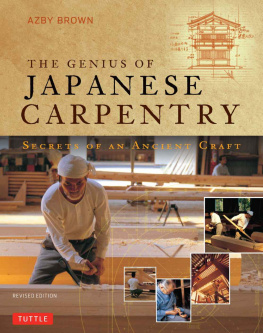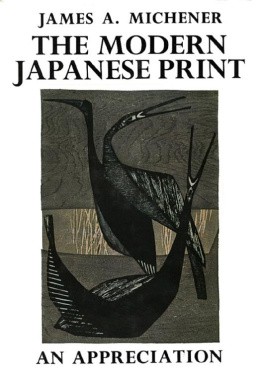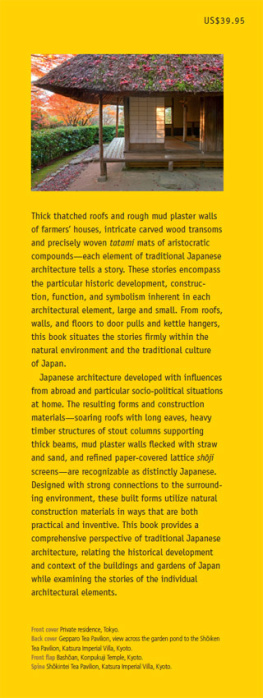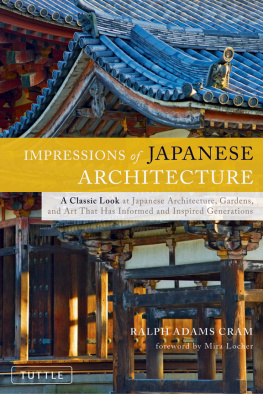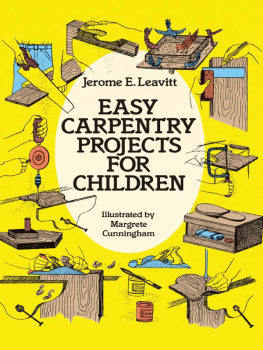
Dear Reader: In order to view all colored text and non-English text accurately, please ensure that the PUBLISHER DEFAULTS SETTING on your reading device is switched to ON. This will allow you to view all non-English characters and colored text in this book. Tuttle Publishing


Figure 1 Corner bracket assembly of the Yakushiji Lecture Hall ( daikodo ).

Figure 2 Tsunekazu Nishioka, regarded as the last of the great master temple carpenters in Japan, photographed in 1986.

In Memory of Maya, Verena, Uri and Master Nishioka
Except where otherwise noted, all photographs and illustrations are by the author.
Published by Tuttle Publishing, an imprint of Periplus Editions (HK) Ltd
www.tuttlepublishing.com
Copyright 2013 by S. Azby Brown
All rights reserved.
ISBN: 978-1-4629-1378-7 (ebook)
Distributed by
North America, Latin America & Europe
Tuttle Publishing
364 Innovation Drive
North Clarendon, VT 05759-9436 USA
Tel: 1 (802) 773-8930
Fax: 1 (802) 773-6993
info@tuttlepublishing.com
www.tuttlepublishing.com
Japan
Tuttle Publishing
Yaekari Building, 3rd Floor
5-4-12 Osaki
Shinagawa-ku
Tokyo 141-0032
Tel: (81) 3 5437-0171
Fax: (81) 3 5437-0755
sales@tuttle.co.jp
www.tuttle.co.jp
Asia Pacific
Berkeley Books Pte Ltd
61 Tai Seng Avenue, #02-12
Singapore 534167
Tel: (65) 6280-1330
Fax: (65) 6280-6290
inquiries@periplus.com.sg
www.periplus.com
15 14 13 10 9 8 7 6 5 4 3 2 1
Printed in Hong Kong 1309 EP
TUTTLE PUBLISHING is a registered trademark of Tuttle Publishing, a division of Periplus Editions (HK) Ltd.
ACKNOWLEDGMENTS
From the 1989 edition:
I wish to express my deep gratitude to Tsunekazu Nishioka for his patience, good humor, advice, and support at all stages of this study and to the Reverend Kin Takada, abbot of Yakushiji temple, without whose permission this publication would have been impossible. Special thanks go also to the Reverend Joukei Fuchigami, formerly of Yakushiji, for providing information concerning the history of the temple, its sect and founder, as well as Buddhism in general. I am also grateful to Professor Hirotar ta of the University of Tokyo for his advice and criticism of my manuscript and drawings. I am especially indebted to the many carpenters, both at Yakushiji and elsewhere, who have patiently answered innumerable questions concerning terminology and procedures and have treated me so warmly.
My sincerest gratitude goes also to the many people who have made my long stay in Japan not only possible but enjoyable, particularly Professor Hisao Koyama of the University of Tokyo, who generously gave me permission to pursue this study as part of my graduate work, and without whose encouragement and assistance any extended stay in Japan would have been impossible. Thanks are due also to the many organizations upon whose assistance I have relied, particularly the Japanese Ministry of Education, the Japan Foundation, and the Ikeda Construction Company, and to those who made my first trip to Japan possible, especially Atsushi Moriyasu, who shares a deep interest in this subject and who, five years ago, surely could not have foreseen this tangible end result of a good word placed with the right people at the right time.
Finally, to Lynne E. Riggs and to everyone at Kodansha International, particularly editors Michael Brase and Shigeyoshi Suzuki and designer Shigeo Katakura, whose selflessness and unflagging energy have buoyed me up through the seas of exhaustion.
For this revised edition:
To the above I would like to add my gratitude to Director Yuji Yamazaki and the staff of Uzumasa Films for involving me, even in a small way, in their fantastic film about Nishioka, Oni ni kike [An Artisans Legacy: Tsunekazu Nishioka], and for providing the photograph on page . Thanks to my colleagues at Kanazawa Institute of Technology for accepting the amount of time I have devoted to this edition, and particularly to Miyako Takeshita, curator at my lab in Tokyo, the KIT Future Design Institute, who assisted in many aspects of research and production. Finally, to Eric Oey, June Chong, Alphone Tea, and the many others at Tuttle for their efforts in seeing this challenging book completed in a form we all can be proud of.

Figure 3 Completed door frames await assembly. (See also Figs..)
Contents

Figure 4 Corner detail of the completed Yakushiji Picture Hall (E-den).
THE GENIUS OF JAPANESE CARPENTRY
Twenty-four years have elapsed since the first edition of this book was released in 1989. Working on a new edition of a book that meant so much to me after an interval of more than two decades has been a rare opportunity for revisiting an extremely formative period of my adult life, for reevaluating my earlier ideas and ideals in light of what I have learned and experienced since that time, for reconnecting with people, with Nara and Yakushiji, and for correcting a (thankfully small) handful of mistakes. It has meant reliving the years I was in contact with Master Nishioka and the countless hours I spent in his workshops and on his building sites, as well as the months taken up with producing the first edition of this book, my first book ever, and reconsidering the many decisions I made about how to best tell the story. More than anything, however, it has meant reflecting on the many changes that have occurred at Yakushiji, in the world of Japanese temple carpentry, in Japanese society, and in myself.
The biggest single change is that Tsunekazu Nishioka died in 1992, just a few years after this book was first published. The buildings in the Sanz-in subcompound of Yakushiji were almost fully complete by then, and one of Nishiokas last official acts as master carpenter of the Yakushiji complex was to officiate at the ceremony commemorating the placement of the first column of the reconstructed surrounding corridor of the main temple complex. Nishioka made a special trip from the hospital where he was being treated for cancer in order to participate. Years earlier, I had already had an inkling that Nishioka was in a race with death, and perhaps that was reflected in some of what I wrote then. He was already in his mid-eighties when we first met, and was planning work which he expected would require two or three decades more to complete. I remember one day, in particular, when our discussion turned to time, and he pointed out how brief a human lifespan was compared to the thousand or more years of a living tree or of a well-built temple, and how that sense of perspective guided his work. On his desk was a familiar pad of gridded paper on which he was calculating dimensions for the reconstruction of the Great Lecture Hall (Daikodo), a very large building whose commencement still lay years in the future. Nishioka expected it would take nearly a decade alone to find suitable timber. Not quite sure that I was understanding correctly, I asked him, So youre preparing everything so the work can be carried out even if youre not here? Whereupon he grinned and said simply, Of course.
Next page
